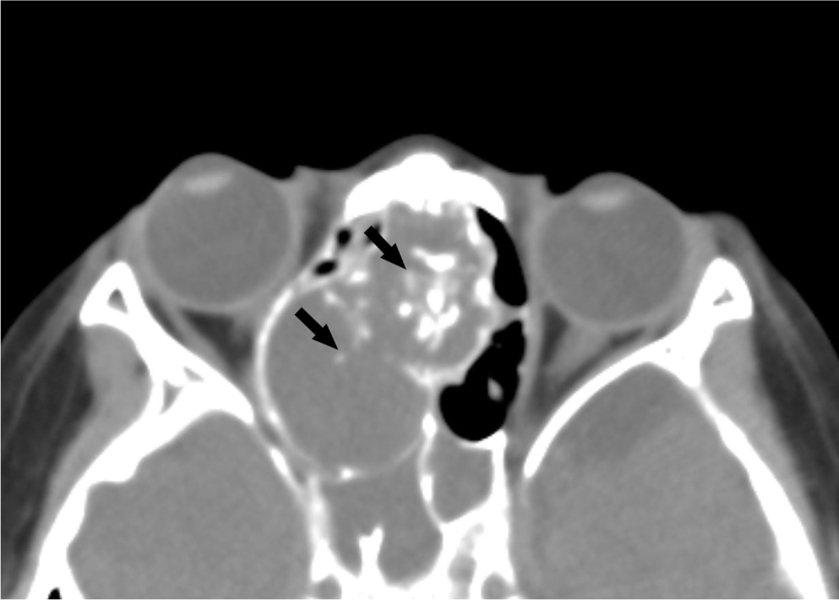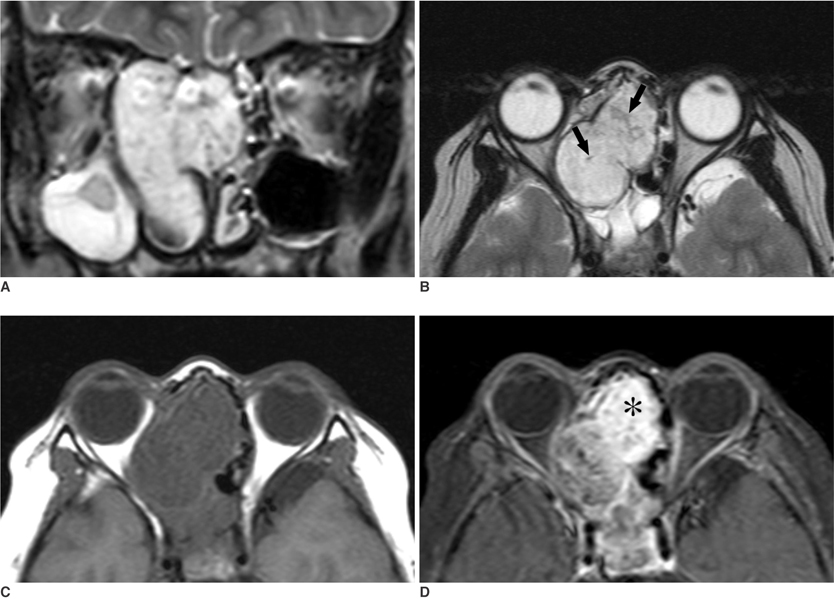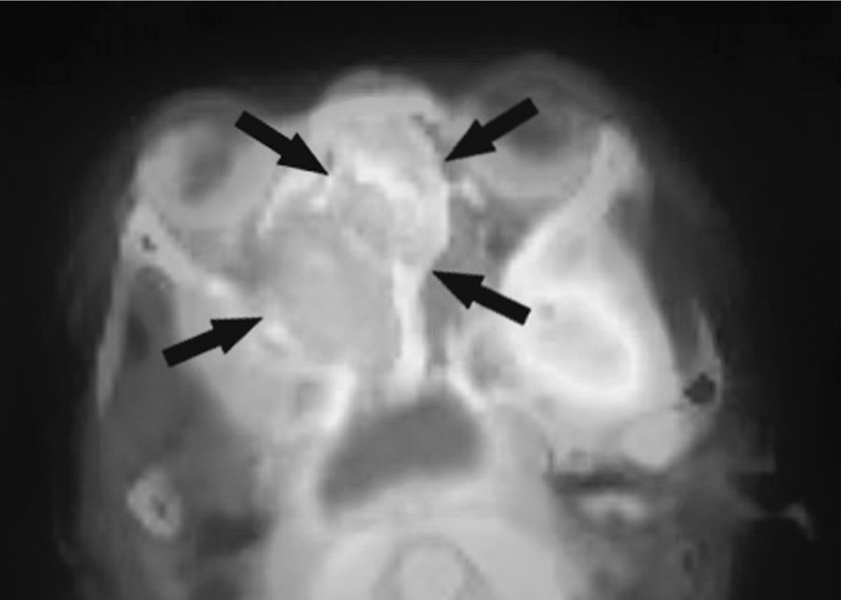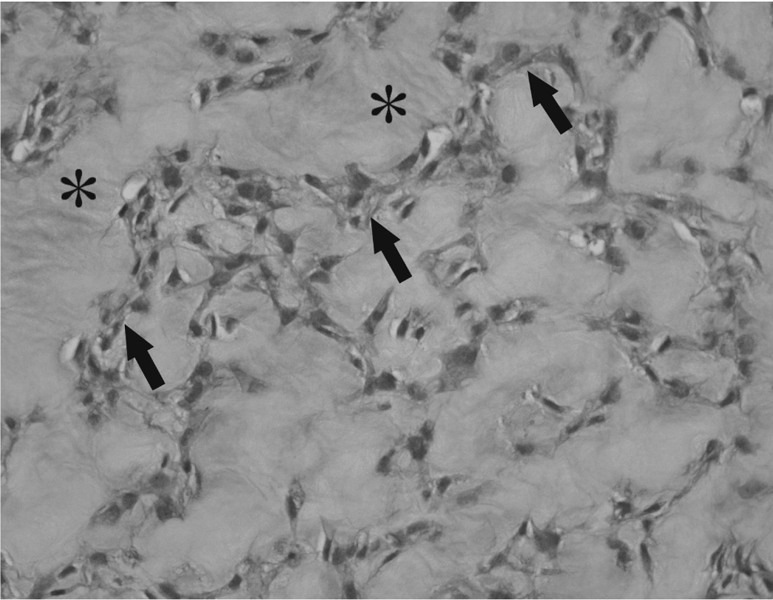Korean J Radiol.
2007 Oct;8(5):452-455. 10.3348/kjr.2007.8.5.452.
Myxoid Chondrosarcoma of the Sinonasal Cavity in a Child: a Case Report
- Affiliations
-
- 1Department of Radiology, Kangnam St. Mary's Hospital, The Catholic University of Korea, Seoul, Korea. saim@catholic.ac.kr
- 2Department of Otolaryngology-Head and Neck Surgery, Kangnam St. Mary's Hospital, The Catholic University of Korea, Seoul, Korea.
- 3Department of Clinical Pathology, Kangnam St. Mary's Hospital, The Catholic University of Korea, Seoul, Korea.
- KMID: 1734296
- DOI: http://doi.org/10.3348/kjr.2007.8.5.452
Abstract
- Chondrosarcomas are malignant tumors of cartilage that rarely involve the sinonasal region, and myxoid chondrosarcoma is a rare histologic variant of chondrosarcoma that usually occurs in the soft tissue of extremities. Although several case reports and results of small series of chondrosarcomas in the sinonasal region in children are available, myxoid type chondrosarcoma is extremely rare. We recently experienced a case of low grade myxoid chondrosarcoma involving the sinonasal cavity in a 10-year-old boy, and here we report its radiologic-pathologic findings. In this case, chondroid calcification on CT and septal and marginal enhancement on MRI suggested a chondrosarcoma. Whole body PET-CT demonstrated no definite metastatic lesion and a low peak standardized uptake value primary tumor. However, no definite distinguishing imaging features were observed that distinguished low grade myxoid chondrosarcoma from conventional chondrosarcoma.
Keyword
MeSH Terms
-
Bone Neoplasms/*diagnosis/radiotherapy/surgery
Child
Chondrosarcoma/*diagnosis/radiotherapy/surgery
Diagnosis, Differential
Follow-Up Studies
Humans
Magnetic Resonance Imaging
Male
Myxosarcoma/*diagnosis/radiotherapy/surgery
Nasal Cavity/*pathology/*radiography/surgery
Paranasal Sinuses/*pathology/*radiography/surgery
Positron-Emission Tomography
Rare Diseases
Tomography, X-Ray Computed
Whole Body Imaging
Figure
Reference
-
1. Gadwal SR, Fanburg-Smith JC, Gannon FH, Thompson LD. Primary chondrosarcoma of the head and neck in pediatric patients: a clinicopathologic study of 14 cases with a review of the literature. Cancer. 2000. 88:2181–2188.2. Jörg S, August C, Stoll W, Alberty J. Myxoid chondrosarcoma of the maxilla in a pediatric patient. Eur Arch Otorhinolaryngol. 2006. 263:195–198.3. Murphey MD, Walker EA, Wilson AJ, Kransdorf MJ, Temple HT, Gannon FH. From the archives of the AFIP: imaging of primary chondrosarcoma: radiologic-pathologic correlation. Radiographics. 2003. 23:1245–1278.4. Tateishi U, Hasegawa T, Nojima T, Takegami T, Arai Y. MRI features of extraskeletal myxoid chondrosarcoma. Skeletal Radiol. 2006. 35:27–33.5. Antonescu CR, Argani P, Erlandson RA, Healey JH, Ladanyi M, Huvos AG. Skeletal and extraskeletal myxoid chondrosarcoma: a comparative clinicopathologic, ultrastructural, and molecular study. Cancer. 1998. 83:1504–1521.6. Kilpatrick SE, Inwards CY, Fletcher CD, Smith MA, Gitelis S. Myxoid chondrosarcoma (chordoid sarcoma) of bone: a report of two cases and review of the literature. Cancer. 1997. 79:1903–1910.7. Brenner W, Conrad EU, Eary JF. FDG PET imaging for grading and prediction of outcome in chondrosarcoma patients. Eur J Nucl Med Mol Imaging. 2004. 31:189–195.8. Kothary N, Law M, Cha S, Zagzag D. Conventional and perfusion MR imaging of parafalcine chondrosarcoma. AJNR Am J Neuroradiol. 2003. 24:245–248.9. Hayashida Y, Hirai T, Yakushiji T, Katahira K, Shimomura O, Imuta M, et al. Evaluation of diffusion-weighted imaging for the differential diagnosis of poorly contrast-enhanced and T2-prolonged bone masses: Initial experience. J Magn Reson Imaging. 2006. 23:377–382.10. Kawaguchi S, Wada T, Nagoya S, Ikeda T, Isu K, Yamashiro K, et al. Extraskeletal myxoid chondrosarcoma: a Multi-Institutional Study of 42 Cases in Japan. Cancer. 2003. 97:1285–1292.
- Full Text Links
- Actions
-
Cited
- CITED
-
- Close
- Share
- Similar articles
-
- Intraspinal Myxoid Chondrosarcoma: Case Report
- A Case of Extraskeletal Myxoid Chondrosarcoma of Pelvic cavity
- Primary Intracranial Myxoid Chondrosarcoma: Report of a Case and Review of the Literature
- Maxillo-facial Extraskeletal Myxoid Chondrosarcoma: A Case Report and Discussion
- Parachordoma of the Chest Wall: 1 case report





